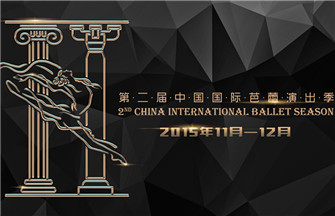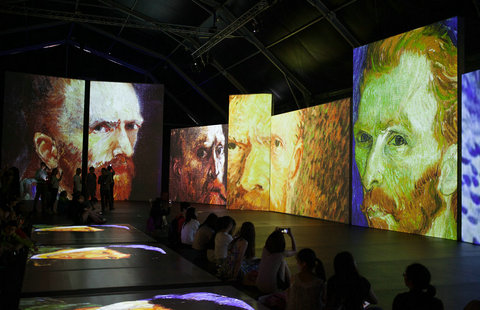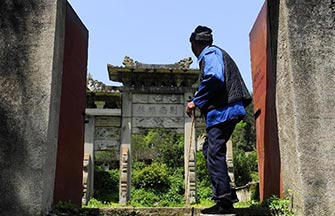Fighting on their feet
By Chen Jie ( China Daily ) Updated: 2015-07-29 10:54:24
 |
|
Jessica Overton (right) from South Africa and Randol Betancourt from Cuba win the best pas de deux at the 3rd Beijing International Ballet and Choreography Competition. [Photo provided to China Daily] |
Taking a deep breath, Romanian Ovidiu Chitanu stepped on stage, eager to perform the role of Albert in Act II of Giselle at the final round of the 3rd Beijing International Ballet and Choreography Competition.
One of the 27 finalists, the 25-year-old dancer impressed the jury with his powerful entrechat. A beautiful leap followed a turn in the air-but suddenly, he fell down, grimacing with pain.
The jury and the audience burst into a sigh.
He tried to get up, but failed. Other dancers waiting in the wings rushed to help. Daniel Wagner from the Cincinnati Ballet Company of America carried him off the stage.
Talking about the accident a few days after the competition, Zhao Ruheng still seemed in shock. The founder and president of the competition's artistic committee says Chitanu's injury reminded her of her own injury some 45 years ago.
Later she learned that Chitanu had just had knee surgery before the competition.
"We all feel so sorry for him. He is such a talented dancer. But I can totally understand his determination to come to the competition to show his talent, to see the global trends and to make friends. That's exactly the reason we organize the competition," Zhao tells China Daily.
After retiring as president of the National Ballet of China in 2008, Zhao has worked as dance director of the National Center for the Performing Arts. Meanwhile, Hong Kong's Yvonne L.K.Lui Foundation approached Zhao to do something related to culture and education, and she focused on a longtime dream-an international competition.
"It's not easy to do such a big competition. You need money, support from the Ministry of Culture, and to invite jurors and recruit applicants," says He Ping, 68, Zhao's former colleague with the National Ballet of China.
In 2011, the first Beijing International Ballet and Choreography Competition was launched at the NCPA, with 70 dancers and choreographers from 20 countries. The second edition in 2013 attracted 86 applicants. This year, 73 dancers and 32 choreographers came to Beijing.
Zhao says the NCPA initially just wanted to host a competition for ballet dancers because they thought the performances would attract a bigger audience. She insisted, however, on a session for choreographers too.
"People only know ballet stars, but the choreographer is the hero behind the curtain," she says.
"We need competition to discover young, talented choreographers."
Before the 2013 event, Zhou Hongtao joined the organizing committee and reached out to potential participants through Facebook, Twitter and other online platforms.
Zhou, who had worked in the Ministry of Education, says he was not then a ballet fan. But he "wished my experience working with international students could help them".
He gradually became fascinated.
"I could meet dancers of different ages-teenage students, young professionals and senior stars," he says.
"It somehow feels like witnessing one dancer's whole career."
To ensure the competition's quality, Zhao insists on inviting a top-notch jury. In the first year, Tamara Rojo, the principal dancer of the Royal Ballet of Britain, was on the jury for the classical ballet session, while Lin Hwai-min, founder and director of the famous Cloud Gate Dance Theater, served as the jury chairman for the choreography session.
This year, Manuel Legris, director of the Vienna State Ballet and former danseur etoile of the Paris Opera, served as chairman of the jury for classical ballet, and Brigitte Lefevre, former director of Dance of the Paris Opera, lead the choreography session.
"The young male dancers impressed me most," says Legris.
"Some performances are better than my expectation. Chinese dancers have good training at school. If there's anything they could do better, it is to be more emotional, to portray the characters. Dance is an art, not only jumping and turning and technique."
Julio Bocca, artistic director of the National Ballet of Uruguay and a juror, says he comes here to discover young talent.
"I saw the beauty of youth from these dancers," says Julie Kent, former principal dancer with American Ballet Theater.
"They have great talent. But talent is not the only reason for a dancer's success. We also need to learn from coaches, choreographers and fellow dancers and then develop our own style."
Lefevre echoes Kent: "Coaches not only teach them techniques but should broaden their vision and develop their passion for learning. The jury's responsibility is the same."
That's why losing applicants get to meet the jury after each round.
"I appreciate this part most," says choreography jury member Sheu Fang-Yi, former principal dancer of the Martha Graham Dance Company.
"The competitor deserves to know why the jury didn't pick him or the piece, and he also wants to know how to improve. A career as a dancer is never easy. You need mentors to critique you and inspire you."
Kou Zuquan, 23, from the China Liaoning Ballet Company, won the gold medal in classical ballet and says that the most important and exciting thing is to meet fellow dancers from different countries.
"I wish to dance abroad to explore something new," says Kou.
The competition also includes master classes, workshops and seminars. This year, some jury members also ran a short summer camp at the Beijing Dance Academy.
Zhao says she is talking with the Youth America Grand Prix, the world's largest global dance network, in the hope of doing a China YAGP session in October.
|
|
|
|
|
|
|
|





















 Raymond Zhou:
Raymond Zhou: Pauline D Loh:
Pauline D Loh: Hot Pot
Hot Pot Eco China
Eco China China Dream
China Dream China Face
China Face






